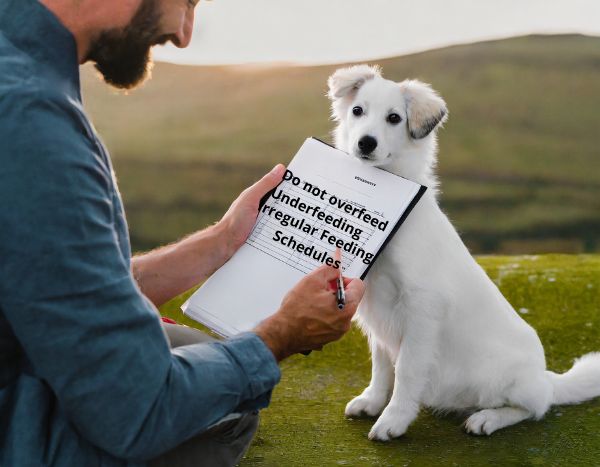Hey there, fellow puppy parents! Are you on the hunt for the ultimate guide to setting up a puppy feeding schedule? Well, you’ve landed in the right place! In this article, we’re diving deep into the world of puppy nutrition, sharing expert advice, and unveiling the secrets to a perfect puppy feeding schedule. So, buckle up and get ready to transform mealtime into a breeze!
The Ideal Puppy Feeding Schedule

Embarking on the journey of puppy parenthood comes with its fair share of joys and challenges, and establishing a feeding routine is right at the top of that list. A consistent feeding schedule is not just a cornerstone for your puppy’s health; it’s a stepping stone towards a happy and harmonious life together.
8-12 Weeks: The Formative Weeks
In these crucial early weeks, your puppy is a bundle of energy, growing and learning at an astonishing rate. Their tiny tummies can’t hold much food at once, so it’s important to spread out their meals throughout the day. Aim to feed your little furball four times a day. This not only supports their rapid growth but also helps in stabilizing their energy levels.
3-6 Months: Building Good Habits
As your puppy grows, their stomach capacity increases, allowing for larger meals and fewer feeding times. During this stage, you can start to reduce their meals to three times a day. This is also an excellent time to establish good eating habits and introduce training around meal times. Consistency is key, so try to feed them at the same times every day.
6-12 Months: Transitioning to Adulthood
Your puppy is now entering adolescence, and their growth rate will start to slow down. This is the time to transition to two meals per day. Keep an eye on their body condition and adjust their food portions accordingly. Large breed puppies may need to stay on a puppy diet for a longer period, so it’s always a good idea to consult with your vet during this transition phase.
Creating a feeding schedule that suits your puppy’s needs is a vital part of their development. It sets the stage for a healthy adulthood, ensuring they get the right amount of nutrients to thrive. For more detailed information on puppy nutrition and feeding schedules, check out this comprehensive guide from the American Kennel Club.
Remember, every puppy is unique, and what works for one may not work for another. Pay attention to your puppy’s cues and adjust their feeding schedule as needed. With a little patience and a lot of love, you’ll find the perfect routine for your furry friend.
Why Consistency is Key

When it comes to feeding your puppy, sticking to a regular schedule is more than just a convenience—it’s a crucial part of their overall well-being. Consistency in feeding times helps regulate your pup’s digestive system, ensuring that they are able to process their food properly and absorb all the necessary nutrients.
A predictable routine not only aids in digestion but also provides a sense of security for your furry friend. Puppies thrive on routine, and knowing when to expect their next meal can help reduce anxiety and promote a calm, balanced demeanor.
Moreover, consistent feeding times play a vital role in house training. Puppies usually need to relieve themselves shortly after eating, so a regular feeding schedule can help establish a consistent potty routine, making the house training process smoother for both of you.
Incorporating consistency into your puppy’s feeding schedule sets the foundation for a happy, healthy life, ensuring they have the energy to play, learn, and grow. So, make mealtime a priority, stick to your schedule, and watch your puppy thrive!
Understanding Your Puppy’s Nutritional Needs

When you bring a puppy into your life, you’re not just getting a furry friend—you’re taking on the responsibility of ensuring they grow up strong and healthy. And a huge part of that is understanding their nutritional needs.
Proteins: The Muscle Builder
Proteins are the building blocks of growth. They play a crucial role in the development of muscles, tissues, and organs. For puppies, a diet rich in high-quality proteins is non-negotiable. Look for puppy food that lists a good source of protein, like chicken or beef, as the first ingredient.
Fats: The Energy Source
Fats provide more than twice the energy of proteins or carbohydrates. They are essential for keeping your puppy active and playful. But it’s not just about quantity; the quality of fats in your puppy’s diet matters too. Look for foods that include omega-3 and omega-6 fatty acids, which contribute to a shiny coat and healthy skin.
Essential Nutrients: The Support System
In addition to proteins and fats, your puppy’s diet should be rich in essential nutrients, including vitamins, minerals, and amino acids. These nutrients support various bodily functions, from vision and brain development to digestion and bone growth.
Special Considerations for Large Breeds
If you have a large breed puppy, pay extra attention to their diet. These pups need a balanced diet to prevent rapid growth, which can lead to joint problems later in life. Look for puppy food specifically formulated for large breeds.

Understanding your puppy’s nutritional needs is a big step towards ensuring they grow up healthy and strong. Focus on providing a balanced diet, rich in high-quality ingredients, and you’ll be setting them up for a lifetime of good health. Remember, when in doubt, consult with your veterinarian to make sure you’re on the right track.
How to Choose the Right Puppy Food: Navigating the Pet Food Aisle
Stepping into the pet food aisle can be overwhelming, with shelves stacked high with various brands and types of puppy food. But fear not! We’re here to help you navigate this maze and choose the best possible food for your furry companion.

Focus on Puppy-Specific Nutrition
First and foremost, ensure that you’re picking up food that is specifically formulated for puppies. Puppies have different nutritional needs compared to adult dogs, and their food should reflect that. Look for brands that specialize in puppy nutrition, as they will have done the necessary research to provide a balanced diet.
Check the Label for the AAFCO Statement
The Association of American Feed Control Officials (AAFCO) sets the nutritional standards for pet food in the United States. When choosing puppy food, always check the label for the AAFCO statement. This ensures that the food meets the required nutritional standards and is suitable for your puppy’s growth and development. You can learn more about AAFCO’s role in pet food regulation on their official website.
Look for High-Quality Ingredients
The quality of ingredients in your puppy’s food matters. Look for a brand that lists a high-quality source of protein, such as chicken or beef, as the first ingredient. Avoid foods that contain fillers like corn or wheat, as these provide little nutritional value. Here is an helpful post on how to find out if dog food is high-quality or not.
Consider Your Puppy’s Breed and Size
Different breeds and sizes of puppies have varying nutritional needs. Large breed puppies, for example, require a different balance of nutrients to support their rapid growth and prevent joint issues. Make sure to select a puppy food that is appropriate for your puppy’s specific breed and size.
Selecting the right puppy food is a crucial step in ensuring your puppy grows up healthy and strong. Take the time to read labels, understand the ingredients, and choose a brand that specializes in puppy nutrition. Your furry friend will thank you for it!
Portion Control: How Much to Feed Your Puppy: Finding the Sweet Spot

Just like humans, puppies need the right amount of food to thrive. Too little, and they won’t get the nutrients they need for growth and development. It is hard to know what to feed a puppy at their different age stages. Too much, and you risk obesity and its associated health problems. So, how do you find that perfect balance? Let’s dive in.
Using Weight as a Guide
One of the most straightforward ways to determine how much to feed your puppy is by looking at their current weight. Most puppy food packages will provide a feeding guide based on weight, giving you a good starting point. However, remember that these are just guidelines. Every puppy is different, and you may need to adjust portions based on their individual needs.
Monitoring Body Condition
In addition to following feeding guidelines, pay close attention to your puppy’s body condition. You should be able to feel their ribs but not see them. If they’re looking a bit round, it might be time to cut back on portion sizes. On the other hand, if their ribs are visible, they may need a bit more food.
Adjusting Portions as They Grow
Puppies grow at an incredible rate, and their food needs will change just as quickly. Be prepared to adjust portion sizes as they grow, and keep an eye on their body condition to ensure they’re staying on track.
When in Doubt, Consult Your Vet
If you’re ever unsure about how much to feed your puppy, don’t hesitate to reach out to your veterinarian. They can provide personalized advice based on your puppy’s breed, age, and health status, ensuring they get just the right amount of food.
Portion control is a crucial part of puppy parenting, but it doesn’t have to be complicated. Use their weight as a guide, monitor their body condition, and adjust portions as needed. With a bit of attention and care, you’ll find that sweet spot and ensure your puppy grows up healthy and strong.
Common Feeding Mistakes to Avoid

Navigating through the puppyhood of your furry friend can be a delightful journey, but it’s not without its challenges. One of the areas where new puppy parents often stumble is feeding. Let’s talk about some common feeding mistakes and how to avoid them to ensure your pup grows up healthy and happy.
Overfeeding: More Isn’t Always Better
It’s hard to resist those puppy eyes, but giving in to them too often can lead to overfeeding. Puppies, especially certain breeds, can be prone to rapid weight gain, which can lead to obesity and associated health problems later in life. Stick to the recommended portion sizes, and resist the urge to offer extra servings.
Underfeeding: Ensuring Adequate Nutrition
On the flip side, underfeeding can also be a concern, particularly for puppies that have higher energy needs. Make sure you’re providing enough food to support their growth and activity levels. If your puppy seems perpetually hungry or is not gaining weight as they should, it might be time to reassess their portion sizes.
Irregular Feeding Schedules: Consistency is Key
Puppies thrive on routine, and this extends to their feeding schedule. Irregular feeding times can lead to digestive issues and can also make house training more challenging. Establish a consistent feeding routine, and stick to it as closely as possible.
Neglecting the Transition to Adult Food
As your puppy grows, their nutritional needs will change. Be mindful of when it’s time to transition from puppy food to adult dog food. This is typically around the 12-month mark for many breeds, but larger breeds may take a bit longer. Make this transition gradually over the course of a week to avoid upsetting their stomach.
Ignoring the Importance of Fresh Water
In addition to their food, make sure your puppy has constant access to fresh, clean water. Hydration is a crucial part of their overall health, and it plays a vital role in digestion and nutrient absorption.
By steering clear of these common feeding pitfalls, you’re setting the stage for a lifetime of good health and happiness for your furry friend. Remember, when in doubt, consult with your veterinarian to ensure you’re on the right track.
Transitioning to Adult Dog Food
Timing is Everything
Just like kids eventually outgrow their baby food, puppies grow up and their dietary needs change. Transitioning to adult dog food is a crucial step in their development, and getting the timing right is key.

Understanding the Right Time
Most puppies are ready to make the switch to adult dog food around the 12-month mark. However, it’s not a one-size-fits-all situation. Larger breeds, with their extended growth periods, may require puppy food for a bit longer—sometimes up to 18 months or even 2 years for giant breeds.
Why the Transition Matters
Puppy food is formulated to support rapid growth and development, with higher levels of protein and fat. Adult dog food, on the other hand, has a different nutritional balance to maintain health and prevent obesity. Transitioning at the right time ensures your dog gets the nutrients they need at each stage of life.
How to Make the Switch
When it’s time to transition, do so gradually over a period of about a week. Start by mixing a small amount of adult food with their puppy food, and gradually increase the proportion of adult food each day. This slow transition helps prevent digestive upset and gives your dog’s system time to adjust.
Monitoring Their Response
Pay close attention to your dog’s response during the transition. Look for signs of digestive upset, such as diarrhea or vomiting, and adjust the transition pace if needed. Once they’re fully transitioned, monitor their body condition and adjust portion sizes as needed to maintain a healthy weight.
Consulting with Your Vet
If you’re ever unsure about when to make the switch or how to do it, your veterinarian is an invaluable resource. They can provide guidance based on your dog’s breed, size, and health status, ensuring a smooth transition to adulthood.
Making the switch to adult dog food is a big step, but with the right timing and a careful approach, it can be a smooth transition. Here’s to the next chapter in your furry friend’s life! Cheers to their continued health and happiness!
FAQs on Puppy Feeding

Navigating through the world of puppy feeding schedules can be a bit of a puzzle, especially for new pet parents. To help clear up some common queries and provide you with reliable information, we’ve compiled a list of frequently asked questions that puppy owners often ask. Let’s dive in and answer some of your burning questions!
How long do puppies need 3 meals a day?
Puppies grow at an incredible rate, and providing them with enough energy to fuel this growth is crucial. From the age of 8 weeks to 6 months, it’s recommended to feed your puppy three meals a day. This helps to evenly distribute their caloric and nutritional intake, ensuring they have a steady supply of energy throughout the day. Once they hit the 6-month mark, you can gradually transition to feeding them twice a day, which is the typical feeding schedule for adult dogs.
How often should I feed my puppy?
The frequency of your puppy’s meals will depend on their age. For the first 8 weeks of their life, puppies usually nurse from their mother. If that’s not possible, a high-quality puppy milk replacer will do the trick, and they’ll need to be fed every 2-4 hours. From 8 weeks to 6 months, you should feed your puppy three times a day. And from 6 months onwards, you can reduce their meals to twice a day. Remember, consistency is key, so try to feed them at the same times every day.
How often should 4-week-old puppies eat solid food?
At 4 weeks old, puppies are in a transition phase, gradually moving from mother’s milk to solid food. At this stage, they should still be nursing, but you can start introducing small amounts of high-quality puppy food, mashed with puppy milk replacer or water to create a gruel-like consistency. This should be done 4-6 times a day. As they get used to the new taste and texture, you can gradually reduce the liquid and increase the amount of solid food.
By providing your puppy with the right nutrition at the right times, you’re setting them up for a lifetime of good health and happiness. If you have any more questions or need further guidance, don’t hesitate to reach out to your veterinarian. They’re there to help ensure your furry friend grows up strong and healthy!
And That is The Perfect Puppy Feeding Schedule!
And there you have it, folks! A comprehensive guide to mastering the art of puppy feeding schedules. From understanding their nutritional needs to navigating the pet food aisle, and from portion control to avoiding common feeding mistakes, we’ve covered it all.
Remember, every puppy is unique, and there’s no one-size-fits-all answer when it comes to feeding schedules and portion sizes. Pay close attention to your puppy’s cues, monitor their growth, and adjust their feeding routine as needed. Consistency is key, and with a bit of patience and attention to detail, you’ll find the perfect balance that works for both of you.
Don’t forget, your veterinarian is an invaluable resource throughout this journey. If you ever have doubts or questions, reach out to them for guidance. They can provide personalized advice based on your puppy’s specific needs, ensuring they grow up healthy and strong.
Feeding your puppy might seem like a daunting task at first, but it’s also an opportunity to bond and create lasting memories. So, embrace the journey, enjoy every moment, and here’s to a lifetime of wagging tails and happy, healthy pups!
Thank you for joining us on this puppy feeding adventure, and happy feeding!
Additional Resources
Embarking on the journey of puppy parenthood is an exciting adventure, and we know you want to do everything right for your new furry friend.
To help you on your way, we’ve gathered a list of additional resources that provide valuable information and support. Dive in, and expand your knowledge on puppy feeding and care. Your four-legged companion will surely thank you for it!
The Puppy-to-Dog Food Transition: When and How to Make the Switch?
This post will give you great insights on how to transition your puppy to adult dog food when they are ready for it.
Unleashing the Secrets: Nutritional Requirements for Adolescent Pups
Here are some great insights on the nutritional requirements for adolecent dogs.
American Kennel Club (AKC) – Puppy Nutrition
The AKC offers a wealth of information on puppy nutrition, helping you understand the essentials of a balanced diet, portion control, and feeding schedules.
PetMD – Puppy Nutrition and Feeding Guide
PetMD provides a comprehensive guide on puppy nutrition, offering insights on what to feed your puppy, how much to feed them, and how to choose the right food.
Veterinary Centers of America (VCA) – Puppy Nutrition
VCA Hospitals offer veterinarian-approved advice on puppy feeding, helping you understand the unique nutritional needs of puppies and how to meet them.
These resources are a great starting point for deepening your understanding of puppy nutrition and feeding practices. Remember, knowledge is power, and the more you know, the better you can care for your furry friend. Happy feeding, and here’s to a healthy, happy pup!

